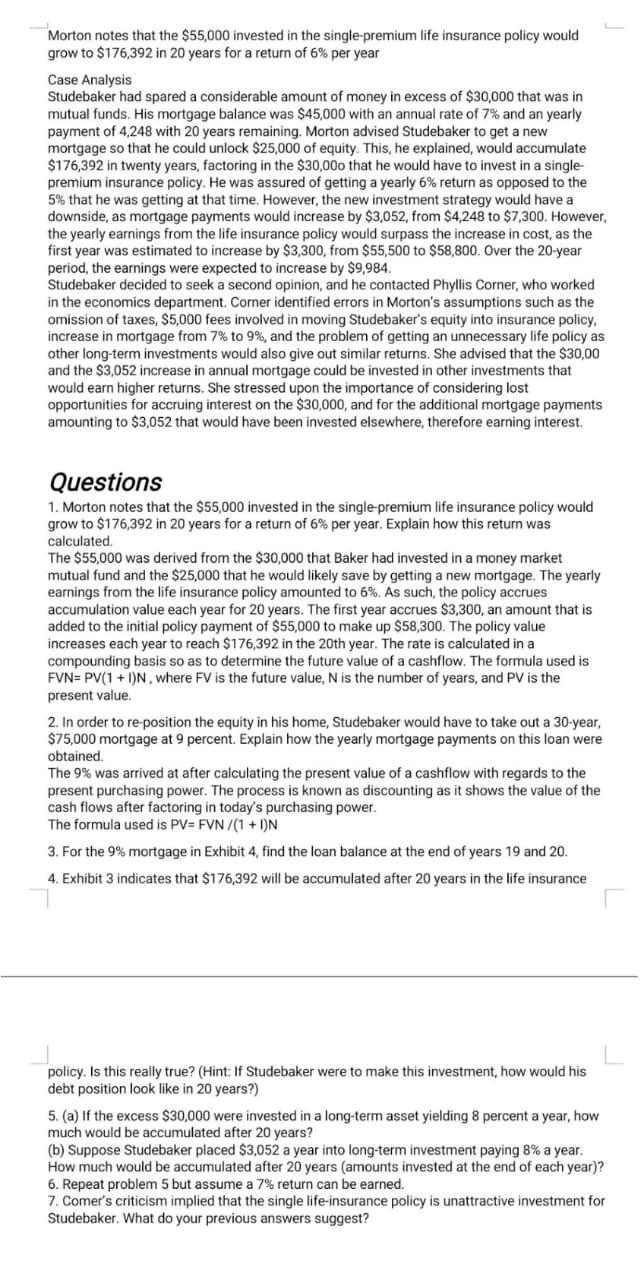Please solve Q no 7
Morton notes that the $55,000 invested in the single-premium life insurance policy would grow to $176,392 in 20 years for a return of 6% per year Case Analysis Studebaker had spared a considerable amount of money in excess of $30,000 that was in mutual funds. His mortgage balance was $45,000 with an annual rate of 7% and an yearly payment of 4,248 with 20 years remaining. Morton advised Studebaker to get a new mortgage so that he could unlock $25,000 of equity. This, he explained, would accumulate $176,392 in twenty years, factoring in the $30,000 that he would have to invest in a singlepremium insurance policy. He was assured of getting a yearly 6% return as opposed to the 5% that he was getting at that time. However, the new investment strategy would have a downside, as mortgage payments would increase by $3,052, from $4,248 to $7,300. However, the yearly earnings from the life insurance policy would surpass the increase in cost, as the first year was estimated to increase by $3,300, from $55,500 to $58,800. Over the 20 -year period, the earnings were expected to increase by $9,984. Studebaker decided to seek a second opinion, and he contacted Phyllis Corner, who worked in the economics department. Corner identified errors in Morton's assumptions such as the omission of taxes, $5,000 fees involved in moving Studebaker's equity into insurance policy, increase in mortgage from 7% to 9%, and the problem of getting an unnecessary life policy as other long-term investments would also give out similar returns. She advised that the $30,00 and the $3,052 increase in annual mortgage could be invested in other investments that would earn higher returns. She stressed upon the importance of considering lost opportunities for accruing interest on the $30,000, and for the additional mortgage payments amounting to $3,052 that would have been invested elsewhere, therefore earning interest. Questions 1. Morton notes that the $55,000 invested in the single-premium life insurance policy would grow to $176,392 in 20 years for a return of 6% per year. Explain how this return was calculated. The $55,000 was derived from the $30,000 that Baker had invested in a money market mutual fund and the $25,000 that he would likely save by getting a new mortgage. The yearly earnings from the life insurance policy amounted to 6%. As such, the policy accrues accumulation value each year for 20 years. The first year accrues $3,300, an amount that is added to the initial policy payment of $55,000 to make up $58,300. The policy value increases each year to reach $176,392 in the 20th year. The rate is calculated in a compounding basis so as to determine the future value of a cashflow. The formula used is FVN=PV(1+1)N, where FV is the future value, N is the number of years, and PV is the present value. 2. In order to re-position the equity in his home, Studebaker would have to take out a 30 -year, $75,000 mortgage at 9 percent. Explain how the yearly mortgage payments on this loan were obtained. The 9% was arrived at after calculating the present value of a cashflow with regards to the present purchasing power. The process is known as discounting as it shows the value of the cash flows after factoring in today's purchasing power. The formula used is PV=FVN/(1+1)N 3. For the 9% mortgage in Exhibit 4, find the loan balance at the end of years 19 and 20 . 4. Exhibit 3 indicates that $176,392 will be accumulated after 20 years in the life insurance policy. Is this really true? (Hint: If Studebaker were to make this investment, how would his debt position look like in 20 years?) 5. (a) If the excess $30,000 were invested in a long-term asset yielding 8 percent a year, how much would be accumulated after 20 years? (b) Suppose Studebaker placed $3,052 a year into long-term investment paying 8% a year. How much would be accumulated after 20 years (amounts invested at the end of each year)? 6. Repeat problem 5 but assume a 7% return can be earned. 7. Comer's criticism implied that the single life-insurance policy is unattractive investment for Studebaker. What do your previous answers suggest







